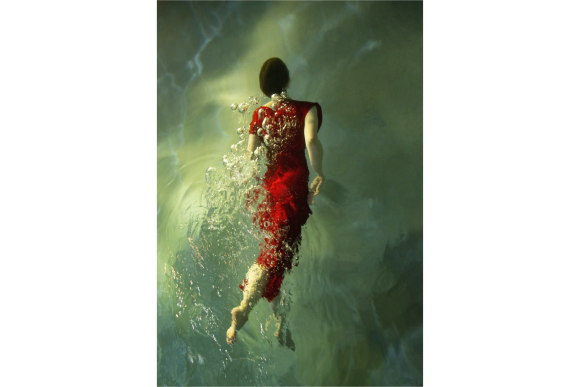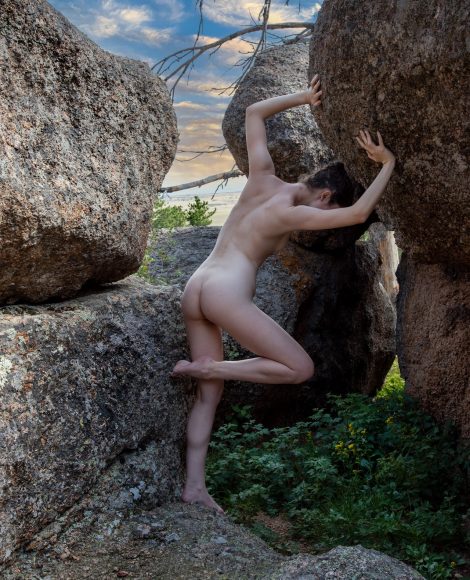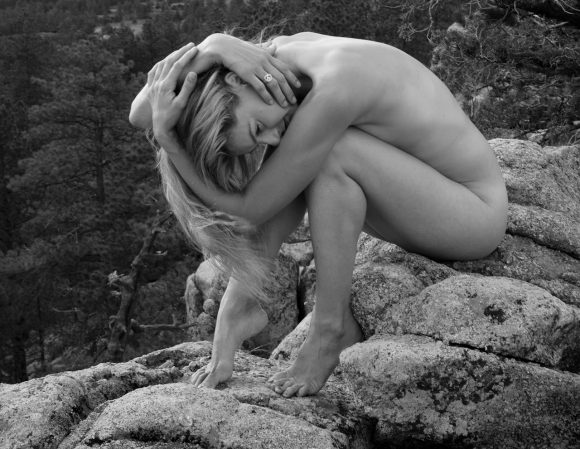
Jerrie Hurd’s “Got My Red Dress On,” (Courtest of Jerrie Hurd)
The J. Macky Auditorium Gallery is typically a quiet space on CU Boulder’s campus. Recently, the gallery has been transformed by a collection of bold photographs that make a loud splash. Jerrie Hurd’s “Beyond The Male Gaze” exhibit opened on Jan. 26 in collaboration with the Boulder Museum of Contemporary Art.
The exhibition, curated by Joan Markowitz, features an assortment of Hurd’s photography from several different series. While each photograph is unique, they share one detail: the subjects are naked.
Hurd’s interest in photography began at a young age, taking classes in high school and college at CU Boulder. She said the artistic form always appealed to her. Following her graduation from the University of Oregon with an MFA in creative writing, Hurd chose to pursue a career as an author.
She published three novels with Pocket Books and several nonfiction books with a regional publisher. While the writing process satisfied Hurd’s creative spirit, she found herself uninspired by the promotional work that came along with it. Hurd said she knew a change was needed to maintain the sense of joy she found in creating art.
While doing research for her new book idea, Hurd rediscovered the work of Anne Brigman: a late Victorian artist and pioneer of nude photography. Brigman captured naked women in natural settings, freeing them from society’s confining clothing and oppressive systems. Brigman’s artistic commentary on societal expectations inspired Hurd to revive her photography career, but this time, focus on the figurative.
“Some modern feminists object to pictures of nude women because they appeal to the male gaze. Anne Brigman argues that it does not help to cover up and that hats, long skirts, and veils are also about the male gaze,” Hurd said. “I think it was that thing that really pushed me back into photography. Needing the fun, but I could have found that somewhere else. I think it was realizing that women photographers need to have their view out there and particularly when it comes to nudes.”

Jerrie Hurd’s “Holding Up That Rock,” (Courtesy of Jerrie Hurd)
Hurd finds the human figure fascinating, housing endless combinations of shapes, imperfections, and proportions. She also understands that bodies have been sources of inspiration in the art world for centuries. Hurd sees herself continuing in that same tradition of somatic appreciation and exploration through figurative photography. This philosophy is also one that Hurd shares with some of the models she works with.
“If I think of my body as a body, I feel insecure. It’s not the right shape, it’s not the right size. We have sanctuaries of language telling women how they should look and how they shouldn’t look,” said Ahna Greene, one of Hurd’s models. “I find the best strategy to be to leave my body at the door. This is me. I am an entity with lines and limbs attached and I will make the lines into something really interesting today.”
According to Hurd, every mode of artistic expression has its unique challenge and, when it comes to figurative photography, the challenge is lighting. Lighting is also one of the most critical elements in Hurd’s creative process, particularly in capturing the nude form in a wide range of environmental settings. Every time the model moves, the lighting falls differently on their bodies, making for a precarious relationship.
She finds this challenge inspiring, rather than discouraging, and is part of what makes figurative photography such an exciting form.
“When you’re doing a nude figure,” Hurd said, “you have to figure out the lighting every minute. Every time she moves, the lighting changes. You have to keep your eye really sharp and that’s what I really like about that nuanced part. The body is an endlessly interesting entity.”
Despite her close attention to detail, Hurd chooses not to use elaborate setups during her photoshoots, preferring a more fluid process. She starts each of her shoots on a relatively blank slate, with a clear idea of what she wants but understanding that the work will take on a life of its own. Additionally, Hurd said she trusts the models to know what will look best on them, making collaboration a focal point of her work. She believes that collaborating with models is critical to her photography’s success, merging her creative vision with their mastery over their bodies. As a result, Hurd goes into each of her projects hoping to obtain the perfect image but not knowing what it will look like.
“Most of the time I’ll tell them what I want, but if they give me something different, I’ll take it,” Hurd said. “They know how their bodies work. It’s like a dance. Between the two of us, we will often find something else in the situation that maybe neither of us knew was there.”

Hurd’s “Hiding My Head” (Courtesy of Jerrie Hurd)
Hurd is excited to continue working on her figurative photography, particularly on water projects and collaborations with male models. While she has already explored it, Hurd also hopes to expand into the Magritte surrealism creative space. She views her writing and photography careers as complementary and hopes to continue finding the magic in both.
Hurd believes that one of the most powerful elements of her photography is that it makes people uncomfortable. By unsettling her viewers, Hurd pushes them to ask important questions about the personal and societal forces responsible for those feelings. Concerning her exhibit, Hurd hopes that viewers will question what the male gaze is, what role it plays in the consumption of her art, and what unwarranted influence it may possess over constructions of nudity in society.
“I can’t tell you how many people say to me ‘why don’t you just photograph something else’, because it makes them a little uncomfortable, or I don’t fit the image of who they think a figurative photographer is,” Hurd said. “I have to tell you, I kind of enjoy those questions. I think ‘okay, I’m stirring the pot just a little bit.’”
“Beyond the Male Gaze” is open at Macky Auditorium through May 26.
Contact CU Independent Staff Writer Jane Forman at jafo7751@colorado.edu.
